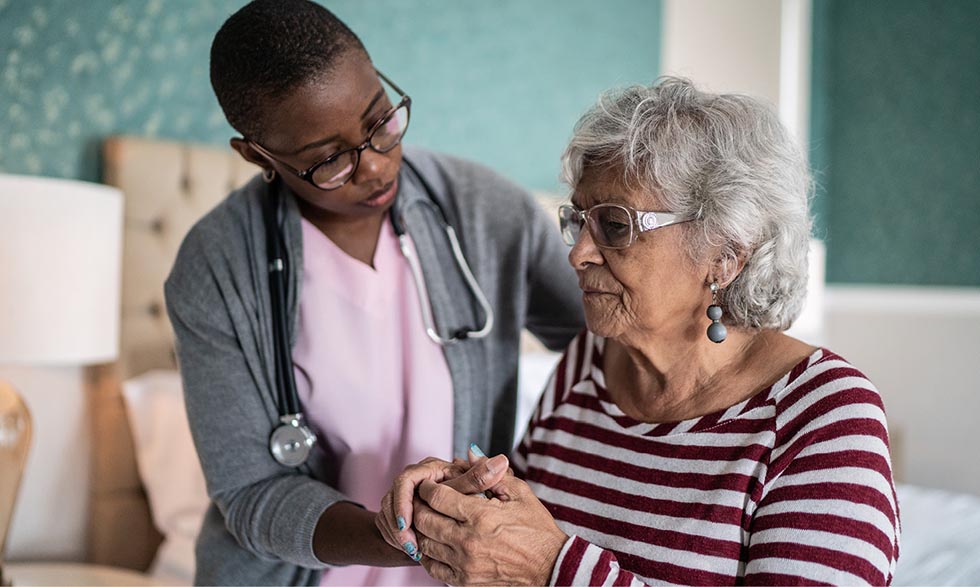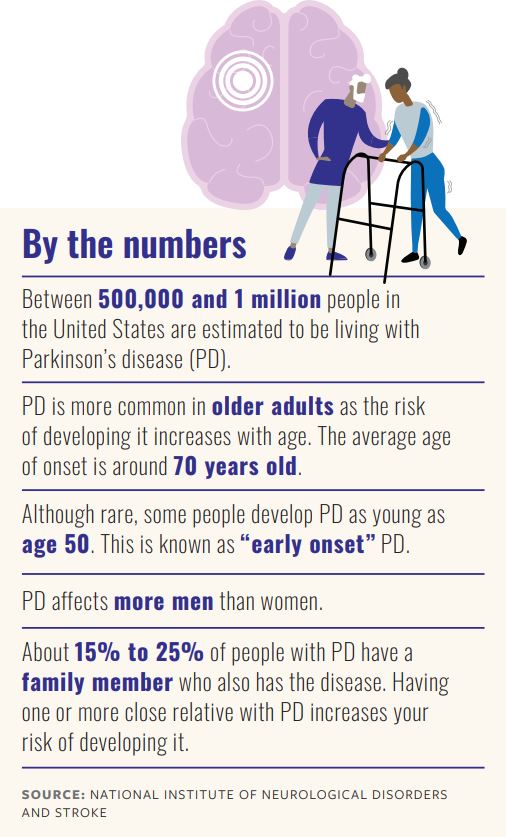Health Topics

Parkinson’s disease explained
What you need to know about this movement disorder
Parkinson's disease (PD) is a progressive movement disorder of the nervous system. PD is one of the most common nervous system disorders, especially among older adults. It’s estimated to affect between 500,000 and 1 million Americans.
Early signs of PD such as a slight hand tremor are often subtle, and symptoms gradually worsen over time. The condition can eventually disrupt balance, making walking and talking difficult. It can also cause serious changes to emotions, cognition (thinking), and sleep patterns.
There’s no cure, but there are treatments that can help manage symptoms.
Who gets Parkinson's disease?
Anyone can develop Parkinson's disease, but men are slightly more likely to develop it than women.
If you have a close family member with PD, your chances of developing it are higher. While some cases are linked to specific genetic mutations, not all are.
Most people first start experiencing symptoms around 70 years old, and the chances of developing it increases with age. But for a small number of people, PD can start sooner, before age 50.
What causes it?
Parkinson's disease happens when nerve cells in specific parts of the brain, particularly in an area of the brain called the substantia nigra, break down and die over time. Many of the cells in this part of the brain are responsible for producing the chemical dopamine, which helps control motor function (movement). When these cells break down, dopamine levels drop, leading to problems with movement.
Scientists don’t know exactly what causes these nerve cells to die, but it likely comes from a combination of genetic changes and environmental influence (such as exposure to air pollution, certain pesticides, and other chemicals).
What are the symptoms?
Parkinson's disease has motor and non-motor symptoms. Some common motor symptoms include:
- Resting tremor or shakiness, especially in a hand, a foot, or the jaw
- Bradykinesia (slowed movement)
- Stiffness or rigidity in the limbs and trunk of the body
- Trouble with speech, balance, and coordination
Early on, someone with PD may notice a slight tremble in their hand or foot. Simple movements like buttoning a shirt can become difficult and take much longer. As the disease progresses, they often develop a distinct, shuffling walk with shorter steps. They may move more slowly, lean forward, and have trouble swinging their arms as they walk. Their face may appear expressionless or have a "masked" appearance (due to decreased blinking and other facial movements).
Non-motor symptoms are also common and may appear years before movement issues. They include:
- Depression, anxiety, and emotional changes
- A poor or lost sense of smell
- Constipation and bladder problems
- Sleep disorders such as sleep-talking and acting out vivid dreams
As the disease progresses, it may cause symptoms such as trouble swallowing, chewing, or speaking, as well as cognitive impairment (problems with thinking) or even dementia.
How is it diagnosed?
There’s no single test for Parkinson's disease. Doctors usually diagnose it based on medical history and a neurological examination.
During the exam, the doctor will look for symptoms like tremor, muscle stiffness, slow movements, and problems with balance and walking. They may also do testing to rule out other disorders with similar symptoms. These tests may include blood and lab tests, as well as brain imaging scans.
If symptoms improve after taking medication, this can help confirm the diagnosis.
How is it treated?
There isn’t yet a cure. But there are treatments available to help relieve symptoms, especially in the earlier stages.
- Medications. Levodopa is a common medication for PD. It helps control motor symptoms by replenishing dopamine levels in the brain. This medication is usually combined with another medication to reduce side effects. Other medications can help treat tremor, rigidity, and non-motor symptoms like depression.
- Deep brain stimulation (DBS). In severe cases where medications aren’t working well enough, doctors may recommend DBS to ease symptoms. Electrodes implanted in the brain send electrical pulses to the parts of the brain that control movement. This can help reduce movement-related symptoms and improve motor function.
- Lifestyle and complementary therapies. A healthy diet, exercise, and therapies like tai chi or dance can help manage symptoms and improve overall well-being.
Most treatments focus on improving the primary movement symptoms. But some medications and therapies can also improve problems with sleep, constipation, and cognition.
Living with Parkinson's disease
Parkinson's disease is a chronic, progressive condition, and there is no way to predict how quickly or severely the disease will progress for any one person. While some people experience mild motor disruptions, others become more severely disabled. But the good news is that many people can live active and fulfilling lives for many years after diagnosis.
Research, resources, and support
The National Institute of Neurological Disorders and Stroke (NINDS) supports PD research at NIH and across the country. Current NINDS-funded research programs are studying how the disease develops and progresses and are working to develop new medications that can delay, prevent, or even reverse it.
If you or a loved one is dealing with PD, you can:
- Learn more about the research that’s happening
- Help with research and improve care for those with PD by getting involved in a clinical trial
- Find organizations that offer resources and support








